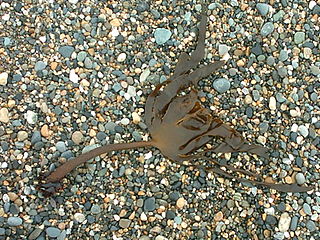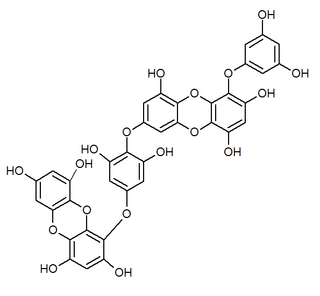
Lessoniaceae are a family of kelp. Species of this family have transition zone with intercalary meristem subdivided so that there are a number of secondary stipes in addition to the primary stipe.
An angiogenesis inhibitor is a substance that inhibits the growth of new blood vessels (angiogenesis). Some angiogenesis inhibitors are endogenous and a normal part of the body's control and others are obtained exogenously through pharmaceutical drugs or diet.

Arame, sea oak is a species of kelp, of the brown algae, best known for its use in Japanese cuisine.

5-Fluoro-α-methyltryptamine (5-Fluoro-αMT), also known as PAL-544, is a putative stimulant, entactogen, and psychedelic tryptamine derivative related to α-methyltryptamine (αMT). It has been found to act as a well-balanced serotonin-norepinephrine-dopamine releasing agent, a 5-HT2A receptor agonist, and a potent and specific MAO-A inhibitor. It produces a strong head-twitch response in mice, and this effect is known to correlate with psychedelic effects in humans, which suggests that 5-fluoro-αMT could be an active psychedelic in humans, although it is not known to have been tested in humans and could be dangerous due to its strong inhibition of MAO-A.

Ecklonia cava is an edible marine brown alga species found in the ocean off Japan and Korea. It is used as an herbal remedy in the form of an extract called Seanol, a polyphenolic extract, and Ventol, a phlorotannin-rich natural agent. Phlorotannins, such as fucodiphlorethol G, 7-phloro eckol, 6,6'-bieckol, eckol, 8,8'-bieckol, 8,4"'-dieckol and phlorofucofuroeckol A can be isolated from Ecklonia cava. Other components are common sterol derivatives.

Ecklonia is a genus of kelp belonging to the family Lessoniaceae.

α-Viniferin is a stilbene trimer. It can be isolated from Caragana chamlagu and from Caragana sinica and from the stem bark of Dryobalanops aromatica. It is also present in relation to resistance to Botrytis cinerea and Plasmopara viticola in Vitis vinifera and Vitis riparia.

Amentoflavone is a biflavonoid constituent of a number of plants including Ginkgo biloba, Chamaecyparis obtusa (hinoki), Hypericum perforatum and Xerophyta plicata.

Phlorotannins are a type of tannins found in brown algae such as kelps and rockweeds or sargassacean species, and in a lower amount also in some red algae. Contrary to hydrolysable or condensed tannins, these compounds are oligomers of phloroglucinol (polyphloroglucinols). As they are called tannins, they have the ability to precipitate proteins. It has been noticed that some phlorotannins have the ability to oxidize and form covalent bonds with some proteins. In contrast, under similar experimental conditions three types of terrestrial tannins apparently did not form covalent complexes with proteins.

Eckol is a phlorotannin isolated from brown algae in the family Lessoniaceae such as species in the genus Ecklonia such as E. cava or E. kurome or in the genus Eisenia such as Eisenia bicyclis.

Beloranib is a former drug candidate for the treatment of obesity. It was discovered by CKD Pharmaceuticals and its clinical development was led by Zafgen. Drug development was halted in 2016 after deaths during clinical trials.
Ecklonia stolonifera is a brown alga species in the genus Ecklonia found in the Sea of Japan. It is an edible species traditionally eaten in Japan.
Ecklonia kurome is a brown alga species in the genus Ecklonia found in the Sea of Japan.

Dieckol is a phlorotannin that can be found in arame, in Ecklonia cava or in Ecklonia stolonifera.

8,8'-Bieckol is an eckol-type phlorotannin found in the brown algae Ecklonia cava and Ecklonia kurome.

6,6'-Bieckol is an eckol-type phlorotannin found in the brown algae Ecklonia cava and Ecklonia stolonifera.

Eckstolonol is a phlorotannin found in the edible brown algae arame and turuarame.

Fucosterol is a sterol isolated from algae such as Ecklonia cava or Ecklonia stolonifera.

Saururus chinensis, commonly known as Asian lizard's tail, is an herb that grows in low, damp places to more than 1 meter high, endemic to China, India, Japan, Korea, Philippines, and Vietnam. Its leaves are green, papery, ribbed, densely glandular, and ovate to ovate-lanceolate, and (4-)10-20 × (2-)5-10 cm in size. Each flower spike resembles a lizard's tail.















